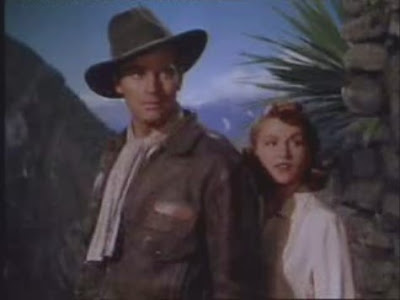Secret of the Incas
 Perhaps precisely because it is portrayed as a place to get rich quick, Latin America is also often seen to be a place to get old slowly. Like a frontier town after a gold rush, it is full both of enthusiastic youth looking to make their fortune, and also old timers who linger on, waiting for the moment when their luck, too, will change. The old and the young show two faces of desperation; it is just that the young do not yet know how desperate they really are.
Perhaps precisely because it is portrayed as a place to get rich quick, Latin America is also often seen to be a place to get old slowly. Like a frontier town after a gold rush, it is full both of enthusiastic youth looking to make their fortune, and also old timers who linger on, waiting for the moment when their luck, too, will change. The old and the young show two faces of desperation; it is just that the young do not yet know how desperate they really are.Such is Cuzco in Secret of the Incas. Charlton Heston plays Harry Steele, the young buck, an American ex-World War Two pilot who is in the Andes to work as a guide earning good tips by charming the lady tourists of a certain age, whether they are accompanied by their husbands or not. He's a hustler, with fingers in many pies and an uneasy friendship with his much older compatriot Ed Morgan. What unites the dashing Steele with the disheveled Morgan, however, is their shared quest for Inca gold. Specifically, both are on the trail of a dazzling but long-lost treasure, a sculpture of the sun encrusted with diamonds.
Steele has in his possession a stone marked with one half of a map that apparently reveals the location of this hidden wonder; he matches it up with the missing half while guiding a group of visitors around the local archaeological museum. On the same tour he also meets up with a flame-haired young woman with a mysterious past: Elena Antonescu, a Romanian refugee who is circuitously trying to make her way to the USA where she hopes to find freedom and fortune. Alas, the Romanian consul is hot on her trail, and Steele refuses to help her out as she only has $50 to her name and money is all that really interests him.
Upon hearing, however, that the Eastern European diplomat has his own plane with which to pursue his prey, Steele senses an opportunity. He lures the man to Cuzco where he and Elena steal the aircraft and fly out of the city. Elena thinks they are headed north, to Ecuador at least, but first Steele wants to make a stop at Machu Picchu: he's not about to leave the country without the artifact of his dreams.
At the Inca citadel, the outlaw duo discover that archaeologists have just uncovered the tomb of the last Inca. Thousands of indigenous people, including Yma Sumac with her rather bizarre multi-octave singing style, have converged on the site in anticipation of the exhumation. Morgan also arrives on the scene, seeking to join forces with Steele and gain a fifty per cent cut of the proceeds of the treasure. Everything is set for a final showdown.
Yet things take a turn as the elderly archaeologist supervising the dig falls for Elena. His love for her, moreover, is untainted by any desire for financial or social advantage. She, in response, begins to rethink her priorities, and accuses Steele of being a money-grubber who will end up no better than the miserable and untrustworthy Morgan. (Note that later this dichotomy between good-hearted archaeologist and dashing young buck will be resolved by making them one and the same person: Indiana Jones, whose sartorial style is clearly drawn directly from Heston's in this film.)
As mirrors start to figure prominently in the plot (the golden sun's location is revealed by light that bounces around the burial chamber), the young man realizes that his older colleague-cum-rival is simply a reflection of his own barren future. So even though he does eventually get hold of the Inca treasure, while Morgan plunges off the mountain to his death, gravity getting him in the end, Steele decides that the true prize is human, not financial. He hands over the golden disk and heads off into the future with his girl by his side.
Within this complex pattern of mirror images that finally decides the movie's outcome, Peru itself becomes the site where our handsome hero first loses sight of himself and then spends some quality time in self-reflection. As so often, Latin America becomes the place to ask "What kind of man am I?"
And though the film starts off by making fun of the Americans who come to the Andes to gawp and be seduced by both the scenery and their guides, eventually Steele decides that he too should only be passing through, to avoid Morgan's fate of perishing so far from home. So for all its initial cynicism, it's no surprise that the film (shot on location in Technicolor) should have famously boosted Peru's tourism industry. Tourism--visiting but not staying--is depicted as a truly educational enterprise, a way to learn more about yourself and to rise above a fixation on the material.

Link: a labor-of-love website devoted to the film.
